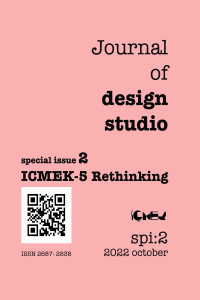A Critical Assessment of an Extended Learning Environment in Interior Design Studio
A Critical Assessment of an Extended Learning Environment in Interior Design Studio
Interior design studio, Interactive experience Experiential retail design, Extended learning environment,
___
- Akin, O., (2002). Case-based instruction strategies in architecture. Design Studies, 23, 407–431. https://doi.org/10.1016/s0142-694x(01)00046-1
- Bagdare, S., Rajnish J., (2013). Measuring Retail Customer Experience. International Journal of Retail and Distribution Management, 41 (10), 790–804. https://doi.org/10.1108/IJRDM-08-2012-0084.
- Brakus, J. J., Schmitt B., Zarantonello, L., (2009). Brand Experience: What Is It? How Is It Measured? Does It Affect Loyalty?., Journal of Marketing, 73 (3), 52–68. https://doi.org/10.1509/jmkg.73.3.52.
- Cachero-Martínez, S., Vázquez-Casielles, R., (2017). Living Positive Experiences in Store: How It Influences Shopping Experience Value and Satisfaction?, Journal of Business Economics and Management, 18 (3), 537–53. https://doi.org/10.3846/16111699.2017.1292311.
- Ceylanlı, Z. & Aktaş Yanaş, E., (2019). İç Mimarlık Tasarım Stüdyosunda Etkileşimli Mekân ve Deneyimsel Mağaza Tasarımı (Interactive space and experiential retail design in the interior architecture design studio). Türkiye’deki İç Mimarlık Eğitiminin Tarihi, Gelişimi ve Geleceği Ulusal Sempozyumu 19-21 Aralık 2019, İTÜ Mimarlık Fakültesi, Taşkışla. (paper presentation)
- Ciolfi, L., (2004). Understanding Spaces as Places: Extending Interaction Design Paradigms. Cognition, Technology & Work 6 (1), 37–40. https://doi.org/10.1007/s10111-003-0139-6.
- Fleischmann, K., (2019). From studio practice to online design education: Can we teach design online?. Canadian Journal of Learning and Technology, 45 (1), 1-18.
- Forest, C. R.; Moore, R. A.; Jariwala, A. S.; Burks Fasse, B.; Linsey, J.; Newstetter, W.; Ngo, P. & Quintero, C., (2014). The Invention Studio: A University Maker Space and Culture. Advances in Engineering Education, 4 (2), 1-32.
- Helmefalk, M., (2019). Browsing Behaviour as a Mediator: The Impact of Multi-Sensory Cues on Purchasing, Journal of Consumer Marketing, 36 (2), 253–63. https://doi.org/10.1108/JCM-10-2017-2392
- Hynes, M. M. & Hynes, W. J., (2018). If you build it, will they come? Student preferences for Makerspace environments in higher education. International Journal of Technology and Design Education, 28(3), 867-883. ttps://doi.org/10.1007/s10798-017-9412-5
- Hornecker, E., (2011). The Role of Physicality in Tangible and Embodied Interactions. Interactions, 18 (2), 19–23. https://doi.org/10.1145/1925820.1925826
- Imrie, R., (2003). Architects’ Conceptions of the Human Body. Environment and Planning D: Society and Space, 21 (1), 47–65. https://doi.org/10.1068/d271t
- Ioannou, O., (2018). Opening up design studio education using blended and networked formats. International Journal of Educational Technology in Higher Education, 15: 47. https://doi.org/10.1186/s41239-018-0129-7
- Masdeu, M. & Fuses, J., (2017). Reconceptualizing The Design Studio in Architectural Education: Distance Learning and Blended Learning as Transformation Factors. Archnet-IJAR: International Journal of Architectural Research, 11(2), 6-23. https://doi.org/10.26687/archnet-ijar.v11i2.1156
- Mallgrave, H. F., (2010). The Architect’s Brain: Neuroscience, Creativity, and Architecture, John Wiley & Sons, Ltd., Publication, ISBN: 978-1-405-19585-0
- Oxman, R., (1990) Prior knowledge in design: a dynamic knowledge-based model of design and creativity. Design Studies, 11 (1), 17-2. https://doi.org/10.1016/0142-694x(90)90011-z
- Oxman, R., (2004). Think-maps: teaching design thinking in design education. Design Studies, 25, 63-91. https://doi.org/10.1016/s0142-694x(03)00033-4
- Pallasmaa, J., (2014). Space, Place, and Atmosphere: Peripheral Perception in Existential Experience. In C. Borch (Ed.), Architectural Atmospheres (pp. 18-41). Berlin, Boston: Birkhäuser. https://doi.org/10.1515/9783038211785.18
- Schmitt, B., (1999). Experiential Marketing. Journal of Marketing Management, 15 (1–3), 53-67. https://doi.org/10.1362/026725799784870496.
- Schmitt, B., (2003). Customer experience management: A revolutionary approach to connecting with your customer. New York, NY: John Wiley & Sons.
- Schmitt, B., (2010). Experience Marketing: Concepts, Frameworks and Consumer Insights. Foundations and Trends in Marketing, 5(2), 55–112. https://doi.org/10.1561/1700000027
- Scupelli, P.; Candy, S. & Brooks, J., (2019). Teaching Futures: Trade-offs Between Flipped Classroom and Design Studio Course Pedagogies. International Association of Societies of Design Research Conference 2019 Proceedings.
- Servais, E., Leroi-Werelds S., Katelijn Q. & Jan V., (2018). “Conceptualizing The Value Of Physical Retailers: Comparing Marketing And Retail Design Perspectives”. Paper presented at the 4th International Colloquium on Design, Branding and Marketing, Hasselt University, Belgium.
- Quartier, K., Stephanie C., Jan V., (2019). A Holistic Competence Framework for (Future) Retail Design and Retail Design Education, Journal of Retailing and Consumer Services, https://doi.org/10.1016/j.jretconser.2019.101914.
- Verhoef, P. C., Katherine N. L., Parasuraman, A., Roggeveen A., Tsiros M., Schlesinger, L.A., (2009). Customer Experience Creation: Determinants, Dynamics and Management Strategies. Journal of Retailing 85 (1), 31–41. https://doi.org/10.1016/j.jretai.2008.11.001
- Vyas, D., van der Veer, G. & Nijholt, A., (2013). Creative practices in the design studio culture: collaboration and communication. Cognition, Technology & Work, 15, 415-443. https://doi.org/10.1007/s10111-012-0232-9
- Yakhlef, A., (2015). Customer Experience within Retail Environments: An Embodied, Spatial Approach. Marketing Theory, 15 (4), 545–64. https://doi.org/10.1177/1470593115569016.
- Yayın Aralığı: Yılda 2 Sayı
- Başlangıç: 2019
- Yayıncı: Orhan HACIHASANOĞLU
Adaptation of First-Year Architectural Design Studio Over Accessible Resources
Re-considering the Architectural Design Studio after Pandemic: Tools, Problems, Potentials
The Dilemmas of Complexity in Design Studios and The Teachers' Role
Bilgen TUNCER MANZAKOĞLU, Renk DİMLİ ORAKLIBEL
Going Digital in Design Education: Restructuring the Emotional Bonds in the Online Studio
Yasemin Burcu BALOĞLU, Ahmet SEZGİN
Adapting to the Living Space in the First Interior Design Studio
Situated Learning in Online Architectural Studio Education
Intuition in the Design Studio: A Perspective on Student’s Creativity and Design Process
Waldemar JENEK, Glenda CALDWELL, Jared DONOVAN, Veronica GARCIA HENSON, Matt ADCOCK, Mingze XI, Kavita GONSALVES
